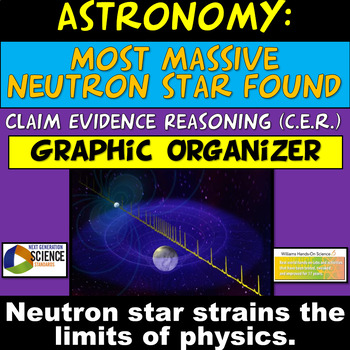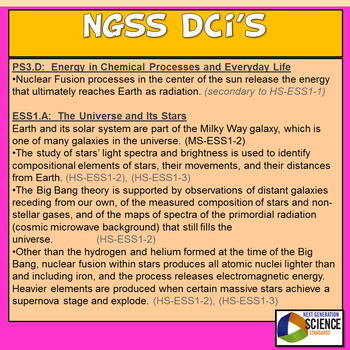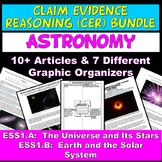ESS1.A PS3.D Claim Evidence Reasoning CER Astronomy Neutron Stars Black Holes
- Zip
What educators are saying
Also included in
- Students learn about various current events and discoveries in Astronomy through a C.E.R. (Claim Evidence Reasoning) graphic organizer. This is great for getting your students to explain phenomena in a meaningful way and it allows you as the instructor to adequately assess their understanding of conPrice $34.00Original Price $66.50Save $32.50
Description
Students learn how the largest Neutron Star was discovered through a C.E.R. (Claim Evidence Reasoning) graphic organizer. This is great for getting your students to explain phenomena in a meaningful way and it allows you as the instructor to adequately assess their understanding of concepts. The students figure out what the "Claim" is in the article, they then use data that supports the claim in the "Evidence" section, draw visual evidence and then explain why the evidence supports the claim in the "Reasoning" section.
The article has the following concepts:
Neutron Stars
Gravity
White Dwarf
Companion Star
Binary Star System
Shapiro Delay
Supernovae
Light-Years
Black Hole
Pulsar
Gravitational Waves
This is great for a current event, sub plan, homework, critical thinking, scaffolding and/or reinforcement of concepts!
You get a CER graphic organizer, an editable key, the article, tips for CER and the link to the website in the article.
NGSS Standards:
DCI's:
PS3.D: Energy in Chemical Processes and Everyday Life
• Nuclear Fusion processes in the center of the sun release the energy that ultimately reaches Earth as radiation. (secondary to HS-ESS1-1)
ESS1.A: The Universe and Its Stars
Earth and its solar system are part of the Milky Way galaxy, which is one of many galaxies in the universe. (MS-ESS1-2)
• The study of stars’ light spectra and brightness is used to identify compositional elements of stars, their movements, and their distances from Earth. (HS-ESS1-2), (HS-ESS1-3)
• The Big Bang theory is supported by observations of distant galaxies receding from our own, of the measured composition of stars and non-stellar gases, and of the maps of spectra of the primordial radiation (cosmic microwave background) that still fills the universe. (HS-ESS1-2)
• Other than the hydrogen and helium formed at the time of the Big Bang, nuclear fusion within stars produces all atomic nuclei lighter than and including iron, and the process releases electromagnetic energy. Heavier elements are produced when certain massive stars achieve a supernova stage and explode. (HS-ESS1-2), (HS-ESS1-3)
SEP's
Asking Questions and Defining Problem:
Students at any grade level should be able to ask questions of each other about the texts they read, the features of the phenomena they observe, and the conclusions they draw from their models or scientific investigations.
Engaging in Argument from Evidence:
In 9–12 builds on K–8 experiences and progresses to using appropriate and sufficient evidence and scientific reasoning to defend and critique claims and explanations about the natural and designed world(s). Arguments may also come from current scientific or historical episodes in science.
CCC's
CCC1: Patterns
Observed patterns of forms and events guide organization and classification, and they prompt questions about relationships and the factors that influence them.
Thank you for taking a look!
Please follow me on TpT for new products and check me out on Instagram for my products in action!
https://www.instagram.com/williamshandsonscience/
Related Products
⭐ Claim Evidence Reasoning (CER) North Korea Missile Launch
⭐ Claim Evidence Reasoning (CER) The Physics of Car Crashes
⭐ Claim Evidence Reasoning (CER): Autumn Equinox Can Fall on Different Days
⭐ Claim Evidence Reasoning California Mudslides (Current Event and Sub Plan)
⭐ Claim Evidence Reasoning Growing Bundle
⭐ Claim Evidence Reasoning Plate Tectonics Pangaea Article and Graphic Organizer
⭐ Claim Evidence Reasoning: Government Report on Human Caused Climate Change
⭐ Hurricane Harvey Claim Evidence Reasoning Graphic Organizer
⭐ Hurricane Harvey Claim Evidence Reasoning Graphic Organizer (NatGeo Article)
⭐ Hurricane Irma CER (Claim Evidence Reasoning) Graphic Organizer
⭐ Hurricane Irma Tracker and PowerPoint
⭐ Hurricane Tracker Template & PowerPoint
⭐ NGSS 5E Natural Selection Computer Simulation
⭐ NGSS Black Holes & Galaxies Claim Evidence Reasoning Graphic Organizer
⭐ NGSS Claim Evidence Reasoning (CER) Big Bang Graphic Organizer
⭐ NGSS Claim Evidence Reasoning (CER) High Frequency Sound Waves
⭐ NGSS Claim Evidence Reasoning (CER) Kilauea Volcano Eruption Earthquakes
⭐ NGSS Claim Evidence Reasoning (CER) Oldest Evidence of Life on Land Found
⭐ NGSS Claim Evidence Reasoning The Mysterious Planet Nine Solar System Astronomy
⭐ NGSS Claim Evidence Reasoning (CER) Water Found on Mars
⭐ NGSS Climate Change & Extreme Weather Claim Evidence Reasoning
⭐ NGSS Common Core Claim Evidence Reasoning (CER) Graphic Organizers
⭐ NGSS Current Event Claim Evidence Reasoning California Wildfires
⭐ NGSS Current Event Claim Evidence Reasoning Climate Change May Change Ecosystems
⭐ NGSS Expanding Universe Claim Evidence Reasoning Graphic Organizer
⭐ NGSS Mysterious New Form of DNA Claim Evidence Reasoning Graphic Organizer






